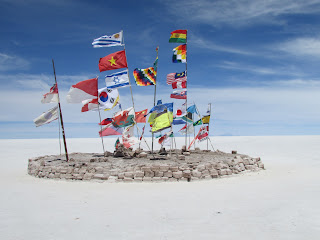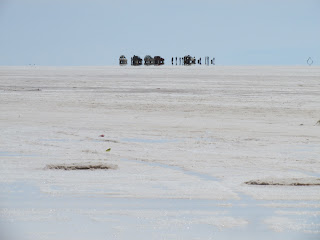San Pedro de Atacama
Early Thursday morning
we fly from the lush Pacific coastal mountains to the Chilean high
altitude deserts. A little north of the Santiago, the Andean range turns
reddish brown, with vast, treeless flat land between the now sparse
peaks. Enormous open pit mines are visible 30,000 feet below. With this
geographical change, Chile's wealth also changes from fruits and
vegetables to minerals, especially copper and nitrates.

We
land at Calama and bus to San Pedro de Atacama, one hour north over
boundless stone deserts. Just before entering San Pedro we see the
sculptured landscape that has transformed San Pedro from a sleepy desert
oasis into a backpacker's paradise. San Pedro resembles a 19th century
western frontier town; small adobe shacks on narrow, dusty, wind blown
streets; crammed with twenty-something migrating backpackers. Every
store is a conglomertion of money exchange, adventure touring, and bike
rentals. Pringles and Escudo beer seem to dominate the backpack's diet.
We spend the next three days mountain biking through the
exotic landscapes that millions of years of wind and rain have moulded
into astonishing vast, open-air, masterpieces, best captured in
pictures, not words – enjoy Simon's photographic gems - the most
impressive of which is the great wall in Valle de la Luna at sunset. We
arrive by bike at the moon-like valley as the sun hovers low in the sky.
 |
| The enormous stone walls reflect a curious, reddish, luminous light
over the valley. |

We bike up a steep hill, with the setting sun in our
eyes. Suddenly human-like silhouettes, appear from the crest of this
desolate hill, silently walking towards us. In the sun's glare, these
blackened figures of all shapes and sizes appear as zombies from the
'Night of Leaving Dead'. With trepidation, we pick-up our pace to pass
them quickly. Over the summit, we spot the tour bus that had deposited
our bike-eating spooks. Relieved, we dismount to enjoy nature's
brilliant spectacle.
Because of San Pedro's famously
clear skies and high altitude, the area is home to the world's second
largest scientific project, ALMA, after CERN's Large Hadron Collider.
When completed it will consist of 66 radio telescopes synchronized
within one millionth of a millionth of a second to produce the
equivalent of a 14,000 metres wide telescope.
We decide
to take a layman's astronomy tour. We leave at 10pm to a remote site
just out of town. As we approach, the bus lights are extinguished and we
are guided by landing-strip lights to the darkened observatory.
A
glorious, bright sky opens above us. With a powerful laser pointer that
seems to reach far into the universe our guide describes the night
sky's stars and planets; and how our ancestors used and fretted over
their movement. We then move to a garden of 11 optical telescopes
pointing to the stellar highlights above. Through one, we see Saturn,
its ring and moons astonish us. Others peer deep inside the Milky-way
and distant constellations. After a welcomed hot
chocolate, we leave, enriched and inspired by the unfathomable
distances and beauty that surround us every night. It has now become our
new custom to wander every evening from the artificial light to
rediscover the gifts above us.
Our Bolivian High Altitude Adventure
 |
| On the 4500 m. plateau, with peaks over 6000 m. |
The
Diamox Shuffle: It's two days before we leave for our 4-day excursion
to the the high-altitude Bolivian desert. With elevations above 5300
meters, altitude sickness is a serious concern. We all had come with a
hefty supply of Diamox, a nasty diuretic designed to reduce any
potential swelling in the brain. However, it comes with a serious
regimen and annoying side effects. It requires drinking 4 litres of
water everyday. That, along with its diuretic effect, means frequent
facility stops – not very attractive when you spending the next 4 days
driving through the desert, crammed in a Jeep. After an exhaustive
debate, we choose the modern medical approach, buy the 30 litres of
water and try not to think about the approaching consequences.
We
quickly discover another minor side effect – the high cost of Diamox
consumption in 3rd world countries where any visit to the facilities
involves a monetary exchange. On the first night, in our primitive adobe
hostel, full of twenty-something-olds, Annice yells out to Esther,
'Don't forget to take the pill!', puzzling our young co-adventurers. Our
Diamox dilemma ended quickly. On tour 3rd night, the hostel's one and
only bathroom is located across a dark, rock-strewn, dirt lane-way. We
look at each other and instantly ditch the Diamox.
The
Bolivian Desert
 |
| Snow-covered smoking volcano |
 |
| Geezers and geyzers |
Active volcanoes blow white whiffs of smoke in the
distance. Extinct, snow-capped volcanoes come in all shapes and colours,
tinged with the red and orange of iron ore. Here, everything is
elemental – base metals and salts. Life is desperately hard;
complex-life rare. Rain falls once a year. The sun scorches the earth
during the day, the night brings subzero cold. By mid-afternoon, the
winds begin their assault, howling incessantly and making outdoor
activities very unpleasant. Often, we would begin our day as early as
6am to avoid the afternoons. Rock and sand stretch to the horizon,
through which, tough, determined shrubs intermittently struggle.
Isolated, strangely metallic coloured lagoons stride the base of tall
snow-capped mountains. Steaming geysers remind us that under this
tranquil, lifeless landscape lie potent, dangerous and impatient forces.
 |
| Un flamenco |
Life begins with the microbes and algae that bloom in
the lagoon waters. Flamingos, in flocks up to 12,000 follow, feeding on
this rich watery food. Vicunas, nimble llama-like animals, surprisingly
also make a living in this Bolivian desolation.
 |
| Muchos flamencos |
 |
| Vicunas |
Vicunas belong to the camelid family. They are wild ones, cannot be domesticated, and so are guanacos which you may remeber we met in Peninsula Valdes and Torres del Paine.
The llamas are domesticated cousins, but herds roam freely in the desert, decorated with colour ribbons to identify the owner. The main thing the owners do for them is use them as pack animals, shear their wool, and slaughter them for meat, which apparently is very tasty (we didn't try it).
 |
| Simon helping a baby llama |
Their other domesticated cousins are the alpaca (famous for their wool) which we didn't see because they live in the very north of Chile and in Peru.
 |
| Quinoa grows in the desert with no irrigation |
At
times, the distant landscape suddenly turns bright green, yellow and
white – fields of ripening quinoa spring from the desert dirt.
One of the desert highlights was visiting the famous salt flat, The Salar near Uyuni, which I talk about separately. The rest is best understood through Simon's pictures.
 |
| Visitor flags at the salar. Note the central one |
Travelling
in Bolivia is unquestionably rough for westerners. That is why it
attracts young backpackers and Israelis – Hebrew could be seen and heard
everywhere. We were told to bring water, soap, towels and toilet paper.
They, however, forgot to tell us about toilet seats and billy-boots
for the bathrooms.
 |
| Salty geezers |
 |
| Salt hotel. Warning self explanatory |
 |
| Tourism ... |
The two main industries of the salt desert. The most lucrative one however is not in the pictures. It is lithium, extracted from the salt.
 |
| ... and salt |
 |
| Watch for crossing llamas... |
The approach to small villages is
signalled by local llamas calmly vacating the road; while the approach
to larger towns is announced with fields of blown plastic bags and other
garbage, small roadside memorial shrines to accident victims and more
llamas.
 |
| I warned you! |
The adobe houses have either collapsed into piles
of discarded rubble or are abandoned half-built.
 |
| Rock holding the corrugated metal roof |
The few habitable
homes have roofs held down by large rocks to fight the desert winds. Even
for a Quebecker, the roads seem impossible. The main road into a town
often requires wading through a stream of unknown depth. Drivers
constantly create new paths around old, rutted main routes. Steep,
rocky, bumpy, virtually impassable paths became our familiar road. Yet despite all this, we loved the adventure and beauty that accompanied us throughout the 4 days.
The Salar near Uyuni (or will Bolivia become the Saudi Arabia of the 21st century?)
 |
| Mountains floating on the salt desert |
A
visit to the salt desert is the highlight of any trip to Bolivia. For
us, it was also an opportunity to learn about the history and politics
of Bolivia. The salt flat covers over 10,000 square kilometres and is 8
meters thick, formed by a transformation of pre-historic lakes. We drove
onto the flats that extend to a 360 degree white horizon. Workers, at
the edge of the flat, shovel salt by hand onto trucks.
 |
| The hostess in our hostel |
Morales,
Bolivian's socialist president has nationalized most industries and
proclaimed that the salt will be for Bolivians and not exported. (With a
population of 10 million that much salt will kill the entire nation
rather quickly). More importantly, lithium – the main component of 21st
century battery technology - has been found in the salt, up to 70% of
the world's supply. But because of the Morales' anti-capitalist
position, few companies are willing to invest in the huge infrastructure
needed to exploit the resource.
On our return drive to
Chile, we spot Chilean soldiers digging in the dirt near the Bolivian
border. We learn that they are looking for land mines leftover from
their 1879 war with Bolivia. In the war, Bolivia lost the nitrate,
copper-rich areas that are now booming in northern Chile as well as its
access to the sea, impoverishing the Bolivians for the last 150 years.
During the First World War, British access to Chilean nitrates (key
ingredient of early 20th century bombs) was a major contribution to its
success.
Leaving the North:
After 10 days in the dry, harsh northern deserts we head back south to the seaside city of Valparaiso - Valley of Paradise - about 100km east of Santiago. It's a major port dating back to the Spanish colonization in the 1500's, and where ships of gold dreamers would rest on the way to the California gold rush in the mid 1800's. Stay tuned as we spend 4 days exploring this crazy, boom and bust city built on 44 hills.

 Near our gate, we found the perfect drinking spot, `The Last
Pisco Sour` bar. We quickly noticed that
our last pisco was indeed special; everything was a lot more interesting and
challenging, including walking - either all our previous Pisco sours and been
watered down or our bartender decided to make sure we would remember our last
one. All I know is that soon after, Air Canada was paging Esther; I was in the
woman`s bathroom shouting for Esther and Annice; and, when I finally got to the
gate, the agent was tying Esther`s shoes.
Near our gate, we found the perfect drinking spot, `The Last
Pisco Sour` bar. We quickly noticed that
our last pisco was indeed special; everything was a lot more interesting and
challenging, including walking - either all our previous Pisco sours and been
watered down or our bartender decided to make sure we would remember our last
one. All I know is that soon after, Air Canada was paging Esther; I was in the
woman`s bathroom shouting for Esther and Annice; and, when I finally got to the
gate, the agent was tying Esther`s shoes.